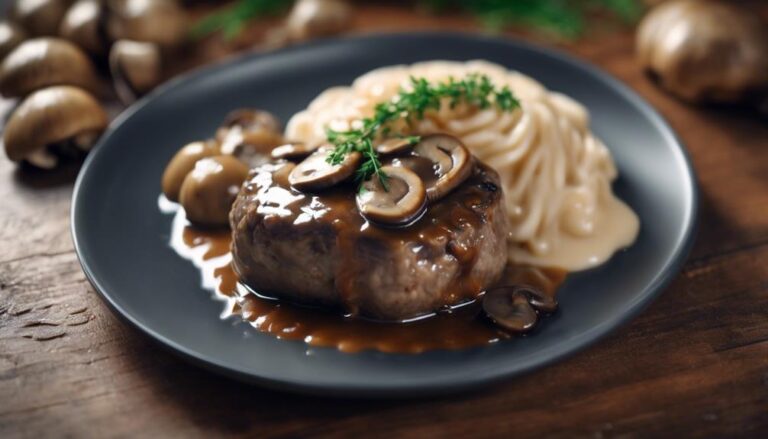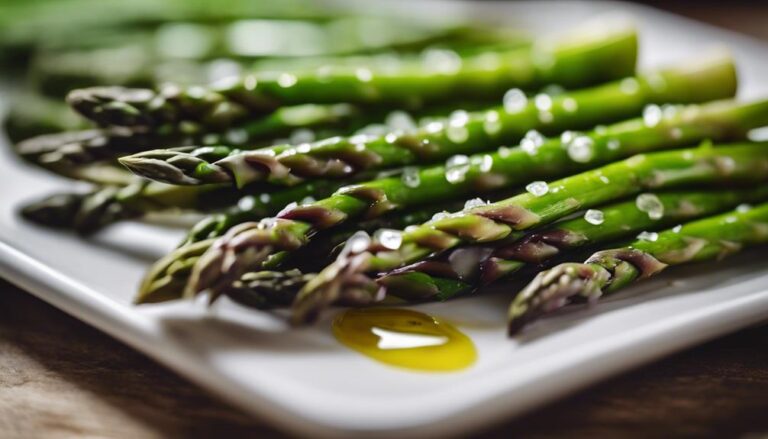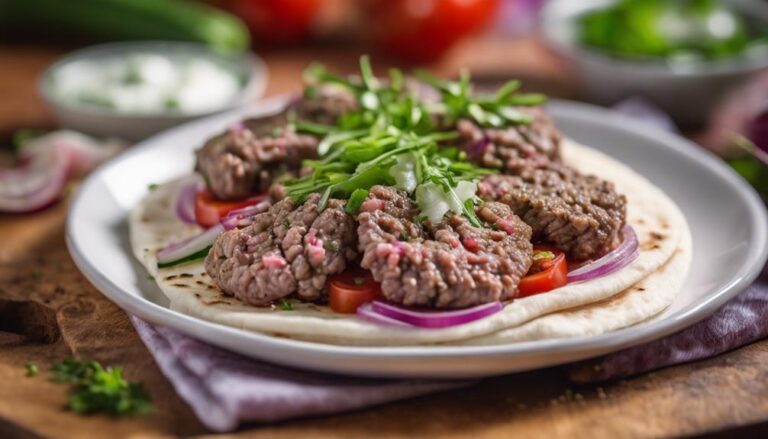Protein Power: the Salisbury Diet's Low-Carb Approach With Sous Vide Cooking
Discover a protein-packed and low-carb journey with the Salisbury Diet blended seamlessly with the flavorful precision of sous vide cooking. Benefit from stabilizing blood sugar and boosting metabolism by indulging in high-quality proteins like chicken, beef, and fish. Elevate your dish with marinades and seasonings, and adhere to specific temperature guidelines for juicy tenderness. Achieve the ultimate balance of energy and metabolic health while savoring delicious flavors. Uncover the secrets to maintaining nutrients, weight loss, and muscle development through this unique fusion of diet and cooking method. Explore a world of protein power and culinary finesse.
What You Will Learn Here
- Salisbury Diet emphasizes low-carb, high-protein meals for weight loss and metabolic health.
- Sous vide cooking enhances tenderness, flavor, and nutrient retention in proteins.
- Opt for lean meats like chicken, beef, and fish for high-protein, low-carb balance.
- Experiment with marinades, seasonings, and precise temperatures for sous vide protein perfection.
- High-protein, low-carb sous vide dishes maintain flavor, texture, and nutritional value.
Understanding the Salisbury Diet
If you're interested in the Salisbury Diet, explore its origins with Dr. James Salisbury's 19th-century low-carb, high-protein approach to health and weight management. Dr. Salisbury believed that focusing on lean meats, like beef, could enhance health and prevent diseases. His diet plan consisted of broiled beef patties and hot water, omitting carbohydrates to promote weight loss. This historical diet regimen aligns with modern protein power diets, emphasizing the significance of protein for various health benefits.
When considering meal planning on the Salisbury Diet, lean protein sources such as beef are essential. Cooking techniques like broiling or grilling can help retain the nutritional value of the meat while enhancing its flavor. The exclusion of carbohydrates in this diet supports weight loss by encouraging a state of ketosis, where the body burns fat for energy instead of glucose.
Nutritional guidelines for the Salisbury Diet focus on high protein intake and minimal carbohydrates. Menu options may include a variety of lean meats like beef, along with non-starchy vegetables. Scientific evidence supports the efficacy of low-carb, high-protein diets for weight loss and improving metabolic health. When meal prepping for the Salisbury Diet, consider incorporating sous vide cooking as a modern technique to guarantee tender, flavorful dishes that retain their nutritional value.
Benefits of Low-Carb Eating
Low-carb eating offers numerous benefits for improving metabolic health and aiding in weight management. By controlling insulin levels and enhancing metabolism, this dietary approach can have a positive impact on your overall well-being. When combined with sous vide cooking, low-carb meals become even more appealing, with benefits extending beyond just health outcomes. Check out the table below to see a breakdown of the advantages of low-carb eating:
| Benefits | Description |
|---|---|
| Insulin control | Low-carb diets help regulate insulin levels, reducing spikes and promoting stable blood sugar. |
| Improved metabolism | By cutting carbs, your body switches to burning fat for fuel, potentially boosting metabolism. |
| Weight management | Low-carb eating can aid in weight loss by reducing appetite and increasing fat burning. |
| Tenderness enhancement | Sous vide cooking ensures proteins like chicken are cooked to perfection, resulting in tender dishes. |
| Flavor enhancement | Sous vide cooking helps retain the natural flavors of ingredients, creating delicious meals. |
Incorporating a low-carb approach into your diet not only supports your health goals but also enhances the taste and texture of your meals. Pairing this with sous vide cooking can elevate your culinary experience to the next level, guaranteeing that every bite is both nutritious and delightful.
Basics of Sous Vide Cooking
Sous vide cooking involves precisely sealing food in a bag and cooking it in a water bath at a specific temperature for a set duration. This method guarantees temperature precision, as the water bath maintains a consistent heat level, making sure that your food cooks evenly. The controlled environment also helps retain moisture, flavors, and nutrients that might be lost in other cooking methods.
Cooking time is vital in sous vide cooking. By following specific time guidelines, you can achieve the desired doneness and texture for your proteins. Water circulation in the sous vide machine ensures that the heat is evenly distributed, cooking your food uniformly throughout.
Vacuum sealing your ingredients before cooking is essential in sous vide. This process removes air from the bag, allowing for better heat transfer and flavor infusion. As the food cooks in its juices, flavors intensify, resulting in a more vibrant and delicious dish.
Choosing the Right Proteins
When considering the Salisbury Diet's low-carb approach with sous vide cooking, your best bet is to focus on selecting the right proteins such as chicken, beef, and fish. These protein sources offer a variety of cooking techniques, flavor profiles, and nutritional benefits that align perfectly with the principles of the diet. Opting for lean cuts of meat not only helps maintain a high-protein, low-carb balance but also ensures a delicious and satisfying meal.
Proteins cooked using sous vide retain their natural juices and flavors, enhancing the eating experience. This cooking method provides precise temperature control, ideal for proteins in the Salisbury Diet. By incorporating sous vide cooking with protein-rich foods, you can effectively manage your weight while enjoying tasty meals.
When planning your meals, consider the different flavor profiles each protein offers. Chicken can be marinated in a blend of spices and citrus juices for a zesty kick, while beef can be seasoned with herbs and garlic for a savory taste. Fish, on the other hand, pairs well with lemon and dill for an invigorating and light meal option.
Incorporating these protein-rich foods into your meal planning guarantees a balanced and satisfying diet that complements the low-carb approach of the Salisbury Diet.
Marinades and Seasonings
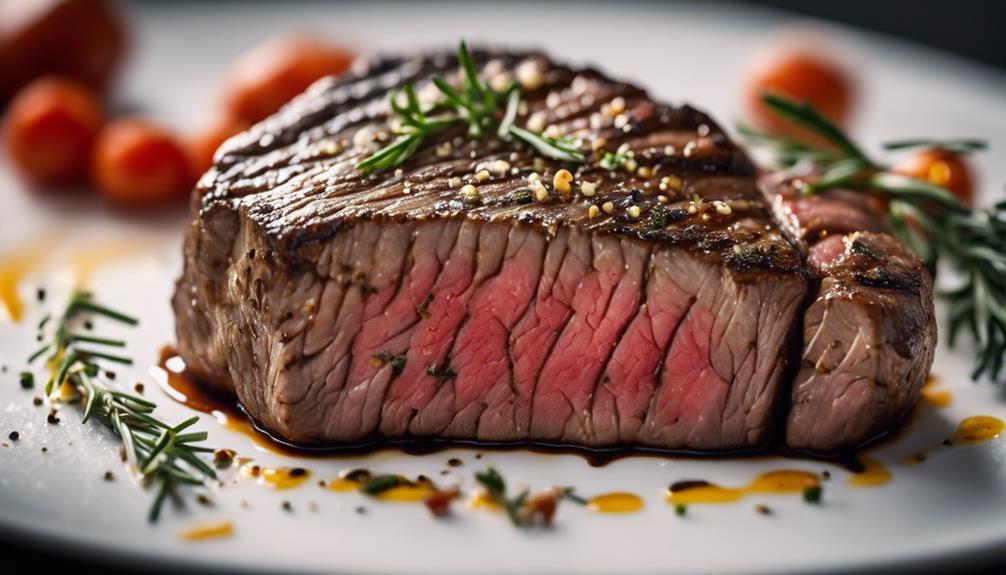
Enhancing your sous vide dishes with flavorful marinades and seasonings can elevate the taste and tenderness of your proteins. When exploring flavor combinations, consider mixing herbs like rosemary and thyme with garlic for a savory profile, or combining soy sauce, ginger, and honey for a sweet and savory twist. Tenderizing techniques play an important role in sous vide cooking, and using acidic ingredients such as vinegar or citrus juices can help break down tough fibers in meats like beef or pork.
Infusion methods are key to getting the most out of your marinades. For a deep flavor infusion, vacuum-seal your proteins with the marinade before sous vide cooking. Seasoning secrets lie in the balance of salt, pepper, and other spices to enhance the natural flavors of the meat without overpowering them. Taste testing throughout the cooking process can help adjust seasoning levels to your preference.
Experimenting with different marinades and seasonings is where the fun begins. Try out new combinations, varying cooking times, and temperatures to find the perfect match for your palate. Sous vide cooking allows for precise control over the cooking environment, ensuring that your proteins are cooked to perfection while maintaining their juiciness and flavor.
Sous Vide Temperature Guide
For best results in sous vide cooking, it's important to adhere to specific temperature guidelines for different types of proteins. Temperature control is vital in sous vide cooking to guarantee that proteins reach the desired level of doneness while maintaining their natural juices and flavors. Different proteins require precise sous vide temperatures to achieve the perfect texture and flavor infusion. By following the sous vide temperature guide, you can enhance the tenderness and juiciness of your dishes.
When using sous vide cooking techniques, it's essential to take into account the protein's ideal temperature for texture retention and flavor development. Cooking proteins at consistent temperatures helps make sure that they're cooked evenly and retain their moisture, resulting in a delicious and perfectly cooked dish. Whether you're preparing chicken, beef, fish, or pork, the sous vide temperature guide provides you with the reference needed to set the correct temperature and cooking time for each type of protein.
Managing Macronutrients

To effectively manage macronutrients on the Salisbury Diet's low-carb approach, focus on balancing protein, fats, and carbohydrates for peak energy levels and metabolic health. Protein balance is vital for supporting weight loss and muscle maintenance, making it a cornerstone of this diet. By incorporating high-quality protein sources like lean meats, poultry, and fish, you can guarantee that your body receives the necessary amino acids for peak functioning.
Carb control is another essential aspect of managing macronutrients on the Salisbury Diet. By reducing your carbohydrate intake and focusing on nutrient-dense vegetables and low-sugar fruits, you can help stabilize blood sugar levels and promote fat loss. This approach also aids in energy optimization, as it prevents spikes and crashes in blood glucose, providing a steady source of fuel for your body.
Maintaining metabolic health is key when following a low-carb approach. By choosing healthy fats like avocado, olive oil, and nuts, you can support your metabolism and overall well-being. These fats are nutrient-dense and help in the absorption of fat-soluble vitamins, further enhancing the nutrient density of your meals. By carefully managing your macronutrients, you can experience the full benefits of the Salisbury Diet's low-carb approach while enjoying delicious and satisfying meals.
Recipe Ideas and Tips
Consider incorporating a variety of herbs and spices to elevate the flavors of your sous vide protein dishes on the Salisbury Diet's low-carb approach. Flavor pairings play an important role in enhancing the taste of your meals. Experiment with combinations like rosemary and garlic for chicken, or cumin and paprika for beef, to create delicious and aromatic dishes. These additions can transform a simple protein into a culinary delight.
When exploring cooking techniques, sous vide offers precise temperature control, resulting in perfectly cooked, tender protein dishes every time. By marinating your protein sources before sous vide cooking, you can infuse deep flavors into the meat, enhancing the overall taste. This method also lends itself well to meal prep, allowing you to batch cook protein-rich foods for convenient and quick low-carb meals throughout the week.
Texture control is another advantage of using sous vide for your recipes. Whether you prefer your proteins rare, medium, or well-done, sous vide cooking ensures that your meat is cooked to perfection. This technique helps maintain the integrity of proteins, resulting in a juicy and satisfying meal every time. Experiment with different protein sources and flavor profiles to discover new and exciting ways to enjoy the benefits of the Salisbury Diet's low-carb approach.
Nutritional Analysis
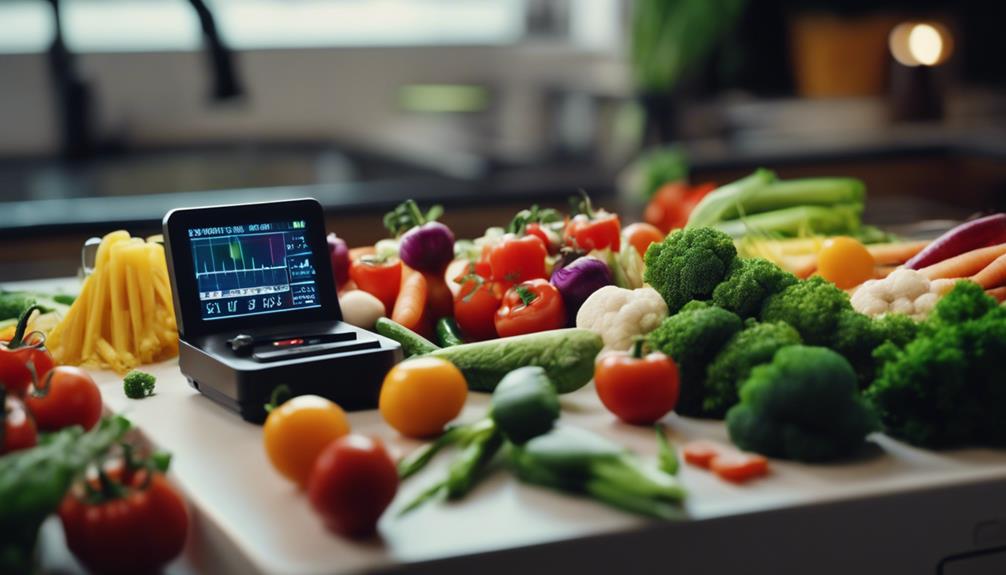
Explore the nutritional benefits of sous-vide-cooked red cardoon to uncover its potential health advantages. Sous vide cooking can help retain more nutrients in food, including the (poly)phenols found in red cardoon, which can support gut health, reduce inflammation, and promote digestive support. These (poly)phenols not only aid in inflammation reduction but also enhance nutrient absorption, contributing to overall well-being.
Incorporating red cardoon into a high-protein, low-carb diet like the Salisbury Diet can offer multiple health benefits. The richness of (poly)phenols in red cardoon, combined with the muscle-building properties of such diets, can aid in weight loss and muscle development. By analyzing the nutritional content of sous-vide-cooked red cardoon, you can gain insights into how this dish can positively impact your health.
Through sous vide cooking, the bioaccessibility of (poly)phenols in red cardoon is optimized, ensuring that the nutrients are readily available for absorption. This method not only helps in maintaining the nutritional integrity of the food but also enhances the potential health benefits it can provide. By incorporating sous-vide-cooked red cardoon into your diet, you can enjoy a flavorful dish while reaping the nutritional advantages it offers.
Maintaining Flavor and Texture
How can sous vide cooking guarantee the rich flavor and tender texture of high-protein chicken dishes on a low-carb diet?
Sous vide cooking excels in enhancing tenderness and ensuring flavor penetration. By marinating chicken with a blend of spices and citrus juices before sous vide cooking, the flavors have ample time to infuse into the meat, leading to a taste profile richness that's unmatched. The essential temperature control of sous vide cooking plays a vital role in achieving texture perfection. Cooking the chicken at 167°F for 2.5 hours guarantees that it's cooked to perfection, resulting in a melt-in-your-mouth texture that will leave you craving more.
Sous vide cooking's cooking precision is what sets it apart when it comes to maintaining flavor and texture. The method allows for consistent cooking throughout the chicken, ensuring that every bite is juicy and flavorful. By incorporating sous vide techniques into the Salisbury Diet's low-carb approach, you can elevate your dining experience with dishes that consistently deliver on taste and tenderness. So, if you're looking for a foolproof way to enjoy delicious high-protein chicken dishes while sticking to your low-carb diet, sous vide cooking is the way to go.
Frequently Asked Questions
What Are the Side Effects of a High Protein Low-Carb Diet?
When you stick to a high protein low-carb diet long term, you might encounter nutrient deficiencies that can impact your health.
Digestive issues like constipation may arise due to inadequate fiber intake.
Metabolic changes from ketosis could lead to temporary symptoms such as headaches.
Be cautious about how this diet affects your athletic performance.
Is a High Protein Low-Carb Diet Good for Weight Loss?
A high protein, low-carb diet can be beneficial for weight loss. By focusing on protein intake, you can support muscle growth, maintain energy levels, and aid in weight management.
Balancing nutrients is key to a successful diet. Remember to consult with a healthcare provider or nutritionist to make sure you're meeting your body's needs while following this approach.
What Happens if I Eat No Carbs for a Month?
If you eat no carbs for a month, your energy levels might dip initially due to the body adjusting to ketones for fuel. Your muscles could be maintained with adequate protein intake.
Digestive changes may occur as your body adapts to a low-carb diet. You might experience mental clarity and potential weight loss, as the body enters ketosis and burns stored fat for energy.
It's essential to monitor your health and nutrition during this dietary change.
Does the Protein Power Diet Keep Sugar in Moderation?
Keeping sugar in moderation is a key aspect of the Protein Power diet. By reducing carb intake, you can help regulate blood sugar levels and control insulin spikes. This can lead to better energy levels, improved glucose balance, and reduced cravings.
Lower carb consumption can also aid in managing hunger and promoting satisfaction, making it easier to maintain a healthy lifestyle while following the principles of the Protein Power approach.
Conclusion
Now that you've mastered the Salisbury Diet's Low-Carb Approach with Sous Vide Cooking, you're ready to enjoy delicious, protein-packed meals that are both satisfying and nutritious.
With the right ingredients, techniques, and creativity, you can continue to explore a world of flavors while staying on track with your health goals.
Keep experimenting, cooking, and indulging in the delightful goodness that this culinary journey has to offer.
Bon appétit!






